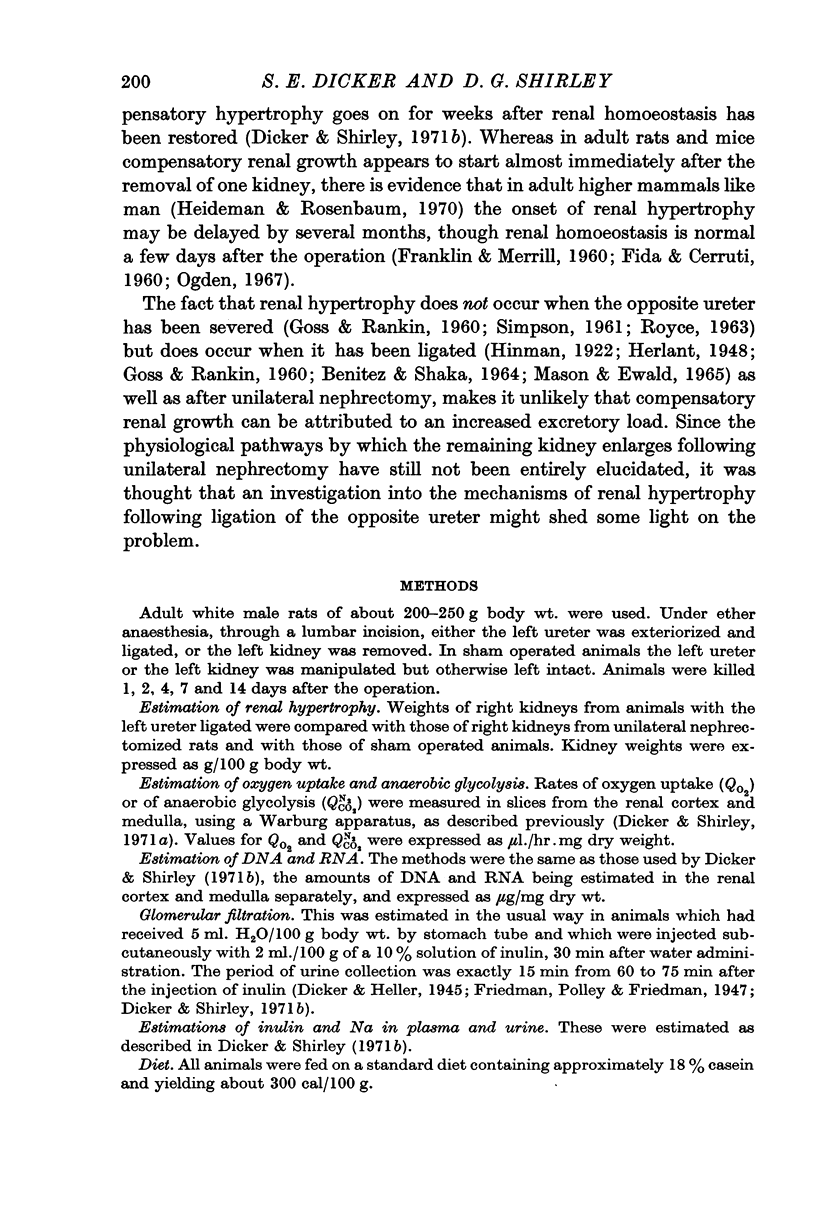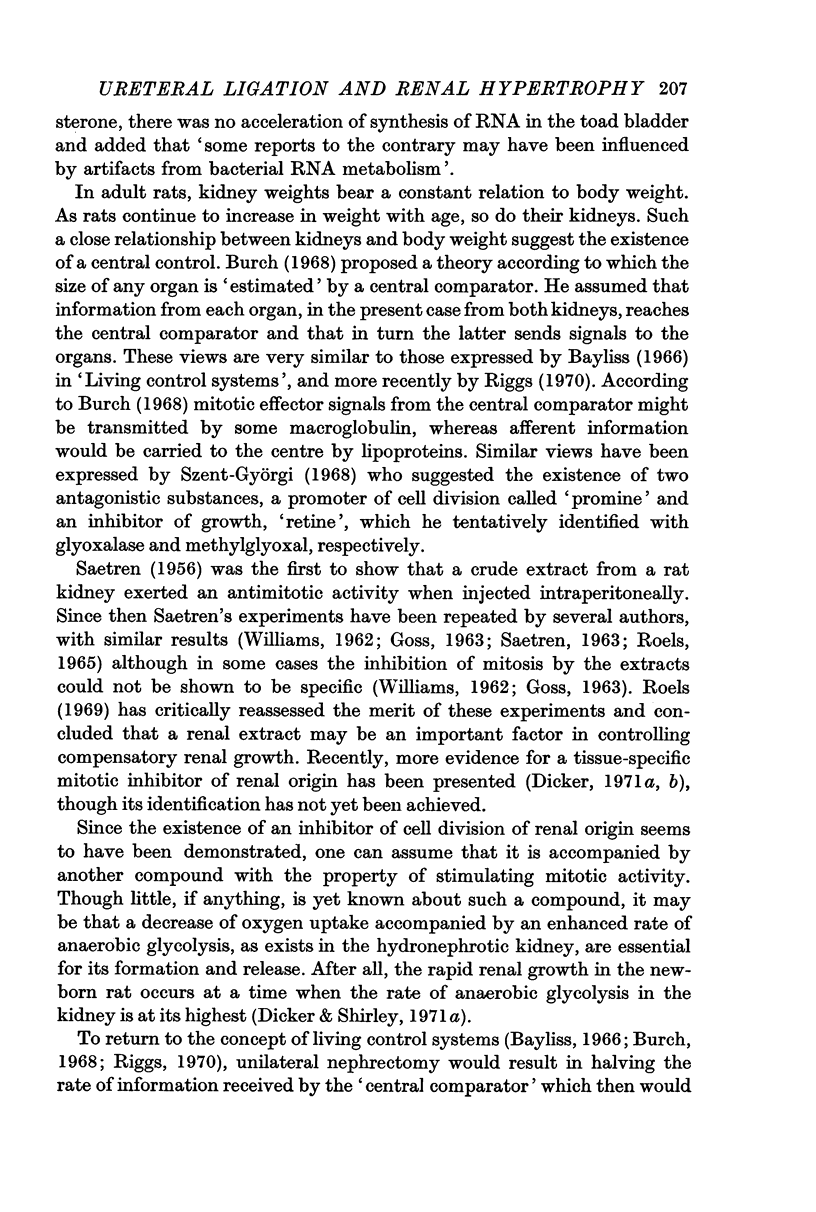Abstract
1. The ligation of one ureter is accompanied by compensatory hypertrophy of the contralateral kidney.
2. The rate of growth of the contralateral kidney after ligation of the opposite ureter is similar to that observed after unilateral nephrectomy.
3. Ligation of one ureter produced ipsilateral hydronephrosis.
4. The development of hydronephrosis was accompanied by a marked increase of DNA, suggesting hyperplasia, and of the rate of anaerobic glycolysis, while the rate of oxygen uptake decreased, especially in the cortex.
5. During compensatory hypertrophy of the contralateral kidney, after ligation of the opposite ureter, there were increases of RNA/DNA ratios and of oxygen uptake, especially marked in the cortex, and in every respect similar to those observed after unilateral nephrectomy.
6. Ligation of one ureter resulted in an increase of glomerular filtration rate of the contralateral kidney similar to that observed after unilateral nephrectomy.
7. The mechanisms of contralateral renal hypertrophy after ligation of one ureter and after unilateral nephrectomy are discussed. It is suggested that in both cases the prime mover to compensatory hypertrophy is the increase of glomerular filtration rate.
Full text
PDF











Selected References
These references are in PubMed. This may not be the complete list of references from this article.
- BENITEZ L., SHAKA J. A. CELL PROLIFERATION IN EXPERIMENTAL HYDRONEPHROSIS AND COMPENSATORY RENAL HYPERPLASIA. Am J Pathol. 1964 Jun;44:961–972. [PMC free article] [PubMed] [Google Scholar]
- BLOCK M. A., WAKIM K. G., MANN F. C. Appraisal of certain factors influencing compensatory renal hypertrophy. Am J Physiol. 1953 Jan;172(1):60–66. doi: 10.1152/ajplegacy.1952.172.1.60. [DOI] [PubMed] [Google Scholar]
- CRANE W. A., DUTTA L. P. The utilisation of tritiated thymidine for deoxyribonucleic acid synthesis by the lesions of experimental hypertension in rats. J Pathol Bacteriol. 1963 Jul;86:83–97. doi: 10.1002/path.1700860110. [DOI] [PubMed] [Google Scholar]
- CRANE W. A., INGLE D. J. TRITIATED THYMIDINE UPTAKE IN RAT HYPERTENSION. Arch Pathol. 1964 Sep;78:209–221. [PubMed] [Google Scholar]
- Carlson E. L., Sparks H. V. Intrarenal distribution of blood flow during elevation of ureteral pressure in dogs. Circ Res. 1970 May;26(5):601–610. doi: 10.1161/01.res.26.5.601. [DOI] [PubMed] [Google Scholar]
- Dicker S. E. Effect of the protein content of the diet on the glomerular filtration rate of young and adult rats. J Physiol. 1949 Mar 15;108(2):197–202. doi: 10.1113/jphysiol.1949.sp004323. [DOI] [PMC free article] [PubMed] [Google Scholar]
- Dicker S. E. Factors influencing compensatory renal hyperplasia. J Physiol. 1971;214 (Suppl):14P–15P. [PubMed] [Google Scholar]
- Dicker S. E., Heller H. The mechanism of water diuresis in normal rats and rabbits as analysed by inulin and diodone clearances. J Physiol. 1945 Mar 28;103(4):449–460. doi: 10.1113/jphysiol.1945.sp004090. [DOI] [PMC free article] [PubMed] [Google Scholar]
- Dicker S. E., Shirley D. G. Mechanism of compensatory renal hypertrophy. J Physiol. 1971 Dec;219(3):507–523. doi: 10.1113/jphysiol.1971.sp009675. [DOI] [PMC free article] [PubMed] [Google Scholar]
- FIDA B., CERRUTI G. B. [The surviving kidney after unilateral nephrectomy. Long-term functional changes in patients with hyperfunctioning of the kidney present prior to the operation]. Minerva Nefrol. 1960 Jan-Mar;7:16–19. [PubMed] [Google Scholar]
- FRANKLIN S. S., MERRILL J. P. The kidney in health; the nephron in disease. Am J Med. 1960 Jan;28:1–7. doi: 10.1016/0002-9343(60)90217-5. [DOI] [PubMed] [Google Scholar]
- Forte L., Landon E. J. Aldosterone-induced RNA synthesis in the adrenalectomized rat kidney. Biochim Biophys Acta. 1968 Apr 22;157(2):303–309. doi: 10.1016/0005-2787(68)90084-1. [DOI] [PubMed] [Google Scholar]
- GOSS R. J. MITOTIC RESPONSES OF THE COMPENSATING RAT KIDNEY TO INJECTIONS OF TISSUE HOMOGENATES. Cancer Res. 1963 Aug;23:1031–1035. [PubMed] [Google Scholar]
- GOSS R. J., RANKIN M. Physiological factors affecting compensatory renal hyperplasia in the rat. J Exp Zool. 1960 Dec;145:209–216. doi: 10.1002/jez.1401450304. [DOI] [PubMed] [Google Scholar]
- Heideman H. D., Rosenbaum H. D. A study of renal size after contralateral nephrectomy. Radiology. 1970 Mar;94(3):599–601. doi: 10.1148/94.3.599. [DOI] [PubMed] [Google Scholar]
- IDBOHRN H., MUREN A. Renal blood flow in experimental hydronephrosis. Acta Physiol Scand. 1956 Dec 31;38(2):200–206. doi: 10.1111/j.1748-1716.1957.tb01384.x. [DOI] [PubMed] [Google Scholar]
- JACOBY F. Mitotic activity in the gall bladder epithelium of the guinea-pig after ligation of the common bile duct. J Physiol. 1953 Feb 27;119(2-3):21P–22P. [PMC free article] [PubMed] [Google Scholar]
- Krohn A. G., Peng B. B., Antell H. I., Stein S., Waterhouse K. Compensatory renal hypertrophy: the role of immediate vascular changes in its production. J Urol. 1970 May;103(5):564–568. doi: 10.1016/s0022-5347(17)62003-2. [DOI] [PubMed] [Google Scholar]
- Mason R. C., Ewald B. H. Studies on compensatory renal hypertrophy. I. Effect of unilateral ureteral ligation and transection. Proc Soc Exp Biol Med. 1965 Oct;120(1):210–214. doi: 10.3181/00379727-120-30488. [DOI] [PubMed] [Google Scholar]
- Moraski R. Renal hyperplasia in the intact rat. Proc Soc Exp Biol Med. 1966 Mar;121(3):838–840. doi: 10.3181/00379727-121-30902. [DOI] [PubMed] [Google Scholar]
- Ogden D. A. Donor and recipient function 2 to 4 years after renal homotransplantation. A paired study of 28 cases. Ann Intern Med. 1967 Nov;67(5):998–1006. doi: 10.7326/0003-4819-67-5-998. [DOI] [PubMed] [Google Scholar]
- ROYCE P. C. INHIBITION OF RENAL GROWTH FOLLOWING UNILATERAL NEPHRECTOMY IN THE RAT. Proc Soc Exp Biol Med. 1963 Aug-Sep;113:1046–1049. doi: 10.3181/00379727-113-28568. [DOI] [PubMed] [Google Scholar]
- Rous S. N., Wakim K. G. Kidney function before, during and after compensatory hypertrophy. J Urol. 1967 Jul;98(1):30–35. doi: 10.1016/S0022-5347(17)62817-9. [DOI] [PubMed] [Google Scholar]
- SAETREN H. A principle of auto-regulation of growth; production of organ specific mitose-inhibitors in kidney and liver. Exp Cell Res. 1956 Aug;11(1):229–232. doi: 10.1016/0014-4827(56)90212-9. [DOI] [PubMed] [Google Scholar]
- SELKURT E. E. EFFECT OF URETERAL BLOCKADE ON RENAL BLOOD FLOW AND URINARY CONCENTRATING ABILITY. Am J Physiol. 1963 Aug;205:286–292. doi: 10.1152/ajplegacy.1963.205.2.286. [DOI] [PubMed] [Google Scholar]
- Suki W. N., Guthrie A. G., Martinez-Maldonado M., Eknoyan G. Effects of ureteral pressure elevation on renal hemodynamics and urine concentration. Am J Physiol. 1971 Jan;220(1):38–43. doi: 10.1152/ajplegacy.1971.220.1.38. [DOI] [PubMed] [Google Scholar]
- Vancura P., Sharp G. W., Malt R. A. Kinetics of RNA synthesis in toad bladder epithelium: action of aldosterone during the latent period. J Clin Invest. 1971 Mar;50(3):543–551. doi: 10.1172/JCI106523. [DOI] [PMC free article] [PubMed] [Google Scholar]
- WILLIAMS G. E. Studies on the control of compensatory hyperplasia of the kidney in the rat. Lab Invest. 1962 Dec;11:1295–1302. [PubMed] [Google Scholar]


